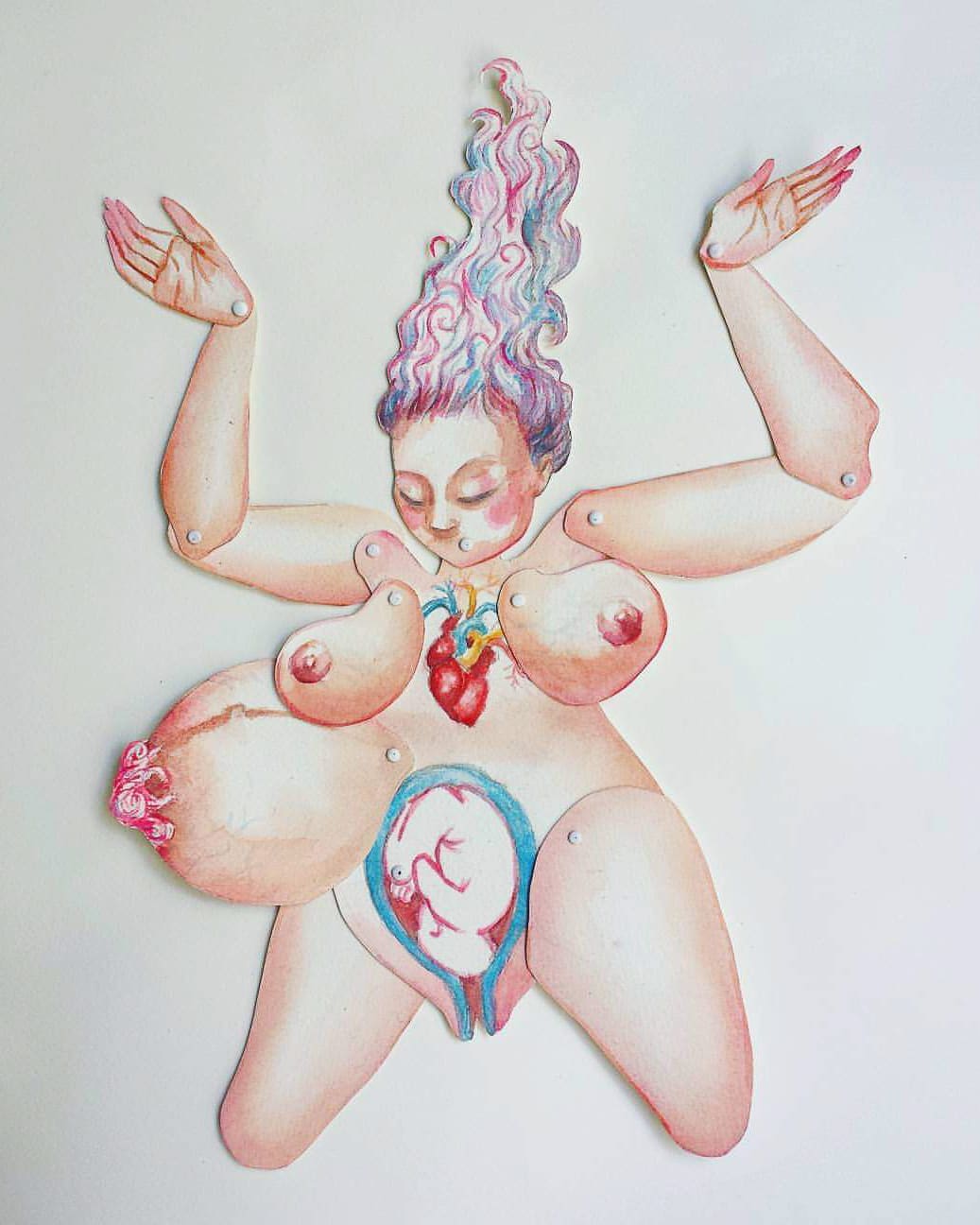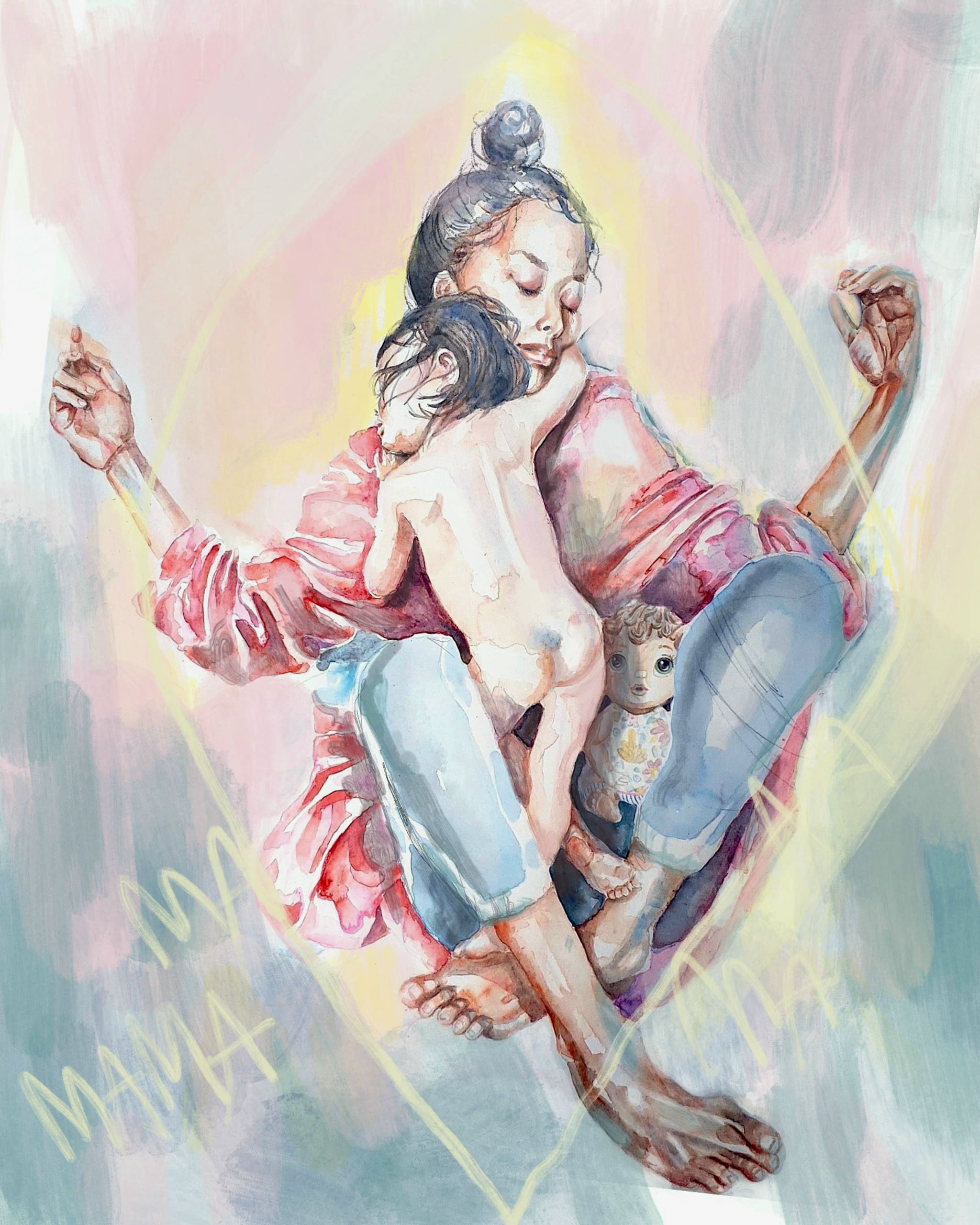“Motherhood with Mandorla”, watercolour and digital painting by Ala Paredes
The man in the red sports car honks at me. He’s been waiting to take my parking space for three whole minutes. I’ve been trying to strap a hysterical infant into her child-seat, which is pretty hard when you’re sleep-deprived. He honks again. I consider giving his bumper a good, hard kick, but instead, I apologize with a smile.
As he pulls into my space, his face says it all: moms and their kids are so annoying.
As a new mother, I’m reminded too often that my child and I take up too much space, that I disrupt every time I wheel a loud infant into a quiet café, when I bare a scandalous breast to feed my baby in public, or beg my friends to schedule our coffee date at an awkward time so my baby can nap on schedule.
There is guilt in receiving all these concessions from society. Do I deserve this? After all, no-one ever asked me to have this baby.
I sometimes wonder if I’m just imagining the side-eye but my treatment in some circles suggests otherwise. During a catch-up with a group of childless friends, I was asked the standard, “What’s new with you?”. As I began to speak of life with an infant, I was shut down with a curt, “Can’t relate.”
It stung. While I didn’t expect my life to be relatable, I did expect them, as my friends, to care. But also, I worried. Had I allowed motherhood to make me boring and myopic? Where once I had other interests, was I now one of those women who speak of nothing but their children?
Then there’s been outright antagonism. At my new workplace, after I’d mentioned in passing that I’d just come from maternity leave, the office alpha male declared, “I hate children. Don’t ever talk about them here.” He meant it.
I was stunned by the aggression, by the invalidation of such a significant part of my life. I felt so unwelcome there that I barely said a word all year.
In the Art Gallery of New South Wales, three brown-skinned children peer back at me from a large painting. “The Divine” is the prize-winning artwork of Filipina-Australian artist, Marikit Santiago. The children are the artist’s own.
The work draws heavily from Christian iconography, and the children are a holy trinity draped in white, their beatific faces haloed in gold. There is an intimacy to the painting that could only have come from the countless hours a mother spends skin-to-skin with her children, whispering to them in the dark. I’m silenced by this gorgeous expression of a mother’s devotion.
I’m emotional because I have seen thousands of portraits at this art gallery, but never anyone with my skin color till now. It’s also never occurred to me that mothers could make artwork about their experiences and have it taken seriously by the art world, an institution that is traditionally white and male.
And while the image of the Madonna and Child has been reincarnated endlessly through the centuries, this tradition was created and established by men. Could it now be time for mothers to tell their own stories?
I read with shock and delight that some strokes and scribbles on “The Divine” were made by Santiago’s children themselves, making them both subjects and co-creators. I’m in awe. How radical, how powerful to be an artist-mother where neither is eclipsed by the other.
In a cafe in Surry Hills, I sit opposite a film director reading out lines from a script, and also trying to ignore the tingling in my breasts that signals feeding time for bub. Hush, I tell myself. She’s in a parked car with her father only a few meters away. She’s fine. Hungry, but fine.
Am I wasting my time even auditioning for this film? It would disrupt the family routine. And even if I did get the role, what was I supposed to do with my breastfed tot who would rather go on hunger strike than take a bottle? I decide that it’s best to turn this gig down.
But when the casting director calls me a few days later offering me the role, I blurt, “I would love to do it…. but can I bring my breastfed baby?”
The reply is tentative but encouraging: “Sure! Of course! But, what exactly would a baby need?”
A few weeks later I am on a film set in the make-up chair. In art imitating life, I’m playing the role of an immigrant, Filipino mother. The crew has allocated a safe area with a mat for the baby to roll around and spend the afternoon with her father. Production goes smoothly, and in between shots, I breastfeed in a dark quiet room. Everyone is calm and happy.
When we finally wrap, I look at my husband rocking our sleeping infant. “We did it,” I say. “You, me, all three of us. We pulled it off.”
And when the film airs a few months later, I’m ecstatic to be representing a Filipino woman on Australian TV, and giving the role authenticity as a mother.
When my child was born, I feared that motherhood would swallow all of me.But I hadn’t counted on the support that came my way when I’d dared to speak my needs out loud. Because I was not alone in this parenting journey. I had a partner who followed me to auditions and film sets, who did the napping and the changing so I could make art and still feed the baby. As for the film crew, they’d accommodated my family when they could’ve just casted another actor in my role, someone who didn’t take up so much space.
As a multidisciplinary creative, motherhood is now the rich soil that nourishes all my roles. Raising my daughter imbues my writing and my painting with new depth and vision. As a teacher, I’ve found my balance between being a nurturer and wearing authority with confidence. And I’m no longer afraid to take up space.
Hostile attitudes towards children are no longer tolerated in my sphere. The things that people hate children for, like being loud, needy, and difficult, are all inherent to a child’s age and not likely to change until they mature. Hating children as a social group speaks not only of lack of compassion, it’s a form of discrimination, no different from being racist, sexist, or ableist.
A society that welcomes children is one that invites mothers to participate. I am committed to telling authentic motherhood stories through my chosen mediums, and validating mothers’ experiences. Mothers need to take up space, not only in art galleries and film sets, but far beyond.

